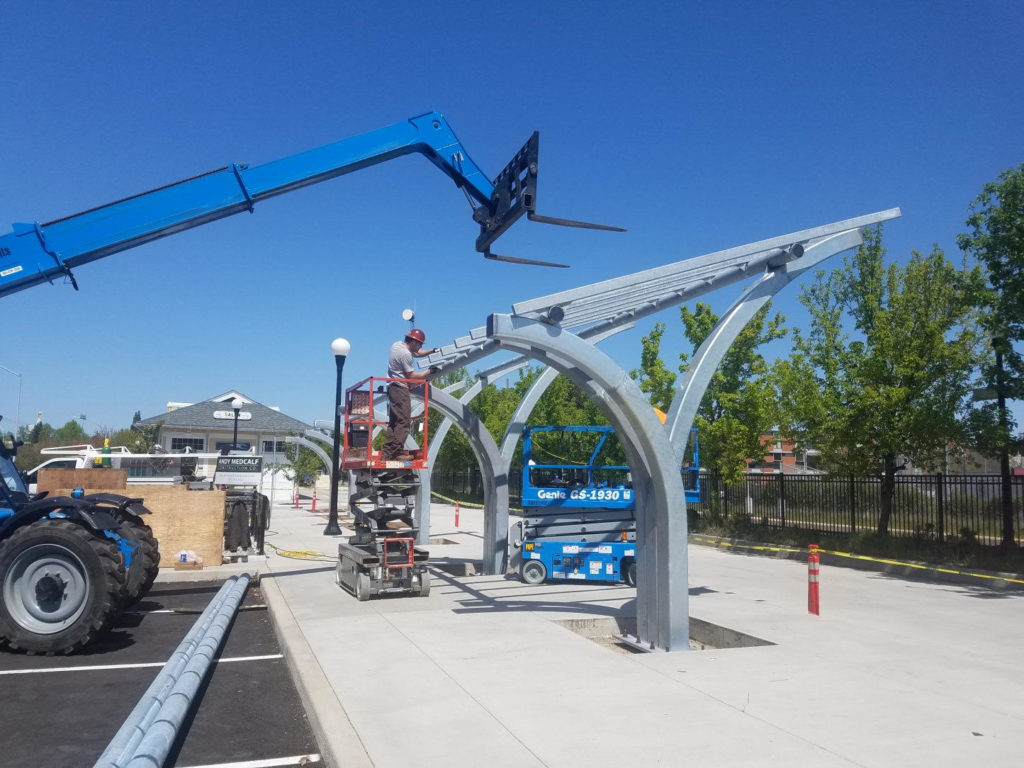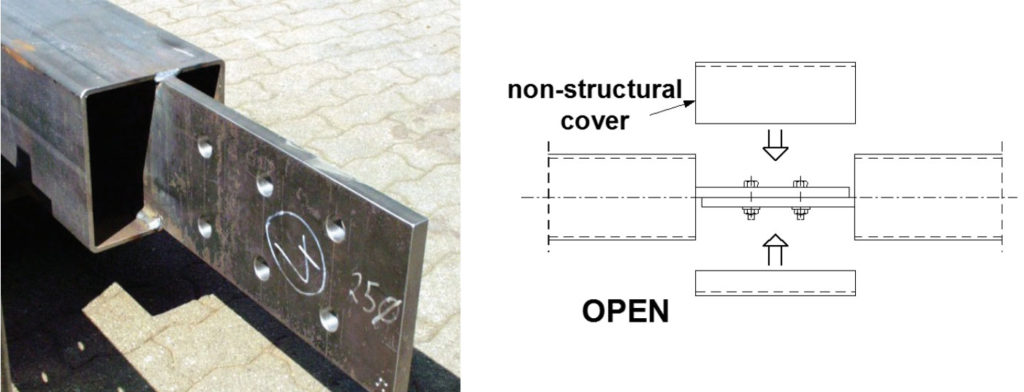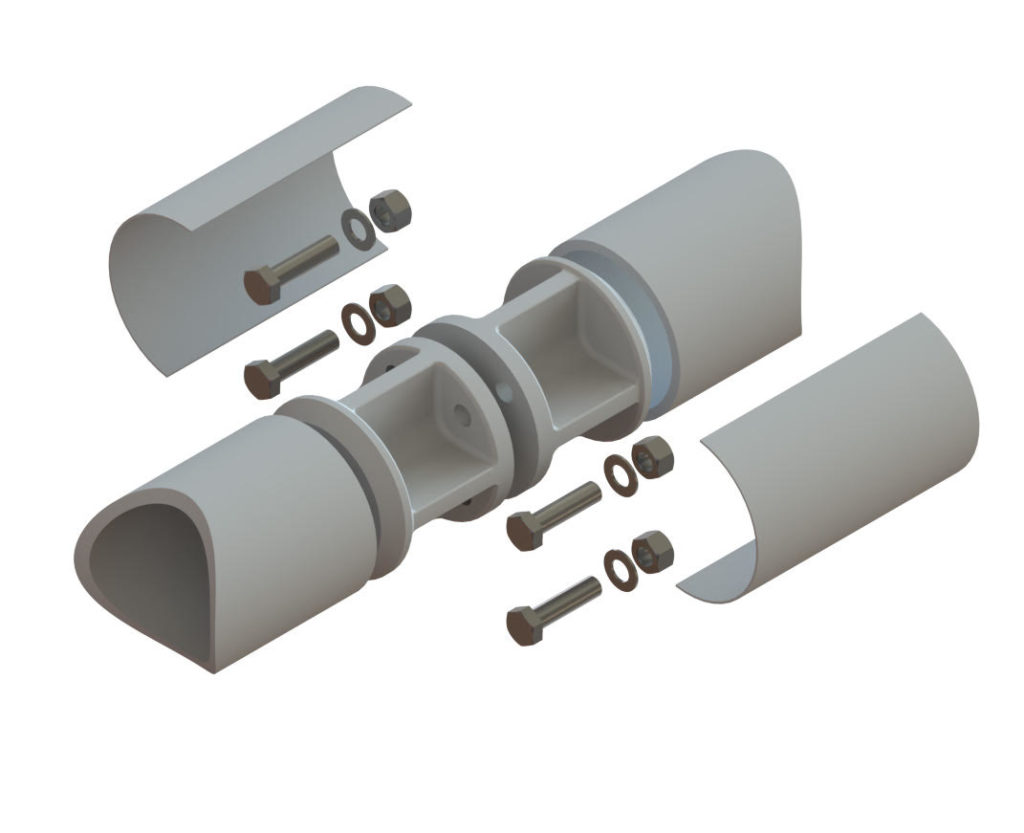Architecturally Exposed Hollow Structural Sections – Part Two – Connections, Finishes and Curved Members
By Cathleen Jacinto, PE, SE
FORSE Consulting, Technical Consultants to the Steel Tube Institute
Last month’s article (AESS e-news article) started a conversation on how to effectively use hollow structural sections (HSS) as architecturally exposed structural steel (AESS). This month we wanted to expand on a few topics we received questions on through our Contact Us page. We will dive a little deeper into the surface finishing of HSS and specifically how it relates to hot-dip galvanized AESS pieces. We will also touch on curved members and a few less-common connections that may be of value when designing an exposed structure.

Finishes
While this article won’t dive into the detail of the paint and primer requirements of AESS, there are two anomalies related to HSS that should be noted. Occasionally, mechanical pipe material (ASTM A53 or API 5L) is substituted for round HSS (ASTM A500 or A1085) in structural applications due to availability and/or pricing. The surface of an HSS, which is intended to be used in this application, closely resembles that of a rolled shape. Care is taken after production of an HSS to handle the material cautiously, store it away from weather and ensure the surface remains smooth. However, due to its intended use, mechanical pipe is not stored indoors, and the surface is not typically protected during handling. This may result in additional surface preparation required prior to priming and painting the AESS piece. Additionally, the surface of mechanical pipes could be described as one having an “orange peel” texture. This difference between pieces may be problematic if these materials are mixed on one project.
AESS is often specified to be hot-dip galvanized, sometimes as a duplex system where the galvanized piece is painted after being dipped. If this is the case, the paint should be carefully coordinated to ensure adhesion with the zinc coating.
Communicating realistic expectations is vital if the AESS pieces are to be hot-dip galvanized but will not receive a paint coat. After galvanizing, the initial appearance of the steel is hard to predict and surface conditions typically acceptable under normal galvanizing practice and corresponding standards may not be acceptable to the architect and/or owner for an AESS piece. It should be communicated to all parties involved that after galvanizing, an AESS piece may need additional surface smoothing and filling due to runs, roughness, and excess zinc drips that are inherent to the galvanizing process. It is prudent to review and specify the pieces meet ASTM A385, Standard Practice for Providing High-Quality Zinc Coatings (Hot-Dip) for AESS pieces. The design team can help achieve a higher quality product by properly specifying the acceptable placement and quantity of venting and draining holes in the HSS. Minimizing the size of the pieces to be dipped will also aid in the finish of the member as it’s difficult to maintain a uniform finish if the piece has to be progressively dipped.
Some factors are out of our control but can be minimized by managing expectations. Even with the best planning, sometimes the finish resulting from the hot-dip process is nonuniform. Because of the irregularities in the steel chemistry, the finish may be inconsistent; sections may vary from a dull finish to those with a bright finish. This effect usually only lasts a few years until the full protective coating of the galvanization process is formed, at which point the finish becomes uniform.
Curving Steel
Curved HSS sections are quite commonly used as AESS. Bending steel requires specialized equipment and is usually subcontracted out to a bender/roller by the fabricator. There are limits to the size of the radius, which is dependent on the size and thickness of the HSS. These limits also differ if the section is rectangular and is being bent about the member’s strong or weak axis.
If bending at a tight radius, deformation or distortion may occur. If distortion is small, an AESS Class 3 or 4 member’s surface may require to be filled and sanded prior to painting to hide the defects. An AESS Class 1 or 2 member with small distortion may not need corrective work.
Due to the varying capabilities of bender/roller’s equipment, standardized criteria are not available. It may be prudent for the fabricator to increase an HSS’s wall thickness above what is required for strength or serviceability to avoid or decrease any distortion which may occur in the bending process.
If possible, curved sections should be designed to be continuous. Splicing curved HSS is very difficult due to distortion variation from one piece to the next and should be avoided.
Connections

As mentioned in the previous article, good communication of expectations is key to avoiding issues or cost overruns during fabrication or construction. One of the major reasons for cost overruns in AESS structures relates to grinding of welds. A note on contract documents specifying “all welds to be ground smooth” is not only not necessary, but it can also be a detriment to the look and strength of the structure. The COSP dictates when grinding of welds may be considered as an option (AESS Class 4 or C), and even then, consider whether it is absolutely necessary. Welds are structural, and overgrinding will diminish their strength.
While welded connections are typically favored for their aesthetics in an AESS application, bolting may also be possible, especially when splicing larger members. As shown in the details below, it is possible to hide splices or connections by specifying a bolted connection that can be hidden by cover plates.

Cast connections are gaining in popularity in North America. While custom castings can be quite expensive, economy can be achieved in mass production of a custom casting or selecting from commonly produced elements. The cost of the casting may be offset if used to simplify an otherwise complex connection. For example, joints where many members are connected at one point can be complicated to fabricate due to intricate cuts, profiling and welding. Using a casting will simplify the assembly.
References
- The 2016 Code of Standard Practice for Steel Buildings and Bridges (ANSI/AISC 303-16), Section 10 Architecturally Exposed Structural Steel.
- CISC Guide for Specifying Architecturally Exposed Structural Steel by Boake, Terri Meyer, Canadian Institute of Steel Construction, March 2012.
- Hochstein, A. (2018, August 2). AESS: Challenges and Opportunities for the Galvanizer. Retrieved from http://galvanizeit.org.
June 2019